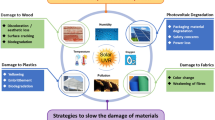Abstract
Laboratory and field exposure results for thin transparent films of a model epoxy coating system have been successfully linked using both dosage and dose, assuming only that the additivity law and the reciprocity law are valid. This paper describes the technique used in the linkage step. Laboratory exposures were carried out on the National Institute of Standards and Technology (NIST) Simulated Photodegradation by High Energy Radiant Exposures (SPHERE) using a factorial design of four temperatures, four relative humidities, four ultraviolet-visible ranges, and four neutral density filters. Similar specimens were exposed on the roof of a NIST laboratory in Gaithersburg, MD. The temperature and relative humidity of the outdoor exposures and the solar spectrum were used to characterize the roof environment at 12 min intervals. Chemical degradation of all specimens was followed by transmission Fourier Transform Infrared (FTIR) spectra. Dose, the radiation incident on the specimens, was estimated from lamp and filter spectra for the SPHERE exposures and from the solar spectra for outdoor exposures. Specimen UV–visible absorbance spectra were used with the estimates of dose to give estimates of dosage—the energy absorbed by the specimens. Using filter ranges for the SPHERE data allowed estimation of relative degradation efficiency over the range of the solar spectrum. This was used implicitly by the computer program to estimate the degradation in specimens exposed outdoors. The paper describes a model-free heuristic approach that automatically predicts chemical degradation outdoors using the outdoor environment parameters and the SPHERE laboratory data. That both dose and dosage are equally valid methods of successfully predicting outdoor degradation may be a consequence of all the films being approximately the same thickness (about 6 μm).













Similar content being viewed by others
References
J Chin, J., W. E. Byrd, E. Embree., J. Garver, B. Dickens, T. M. Finn, J. W. Martin, Accelerated UV weathering device based on integrating sphere technology. Rev. Sci. Instr, 75(11), 4951-4960 (2004) doi:10.1063/1.1808916.
J. W. Martin, S. C. Saunders, F. L. Floyd, J. P.Wineburg, Methodologies for Predicting the Service Lives of Coating Systems. Federation of Societies for Coatings Technology: Blue Bell, PA. (1996).
Gu, X, Stanley, D, Byrd, WE, Dickens, B, Vaco-Trigo, I, Meeker, WQ, Nguyen, T, Martin, JW, “Linking Accelerating Laboratory Test with Outdoor Performance Results for a Model Epoxy Coating System.” In: Martin, JW, Ryntz, AR, Chin, J, Dickie, RA (eds.) Service Life Prediction for Polymeric Materials, Global Perpectives, p. 3. Springer, New York (2009)
A. Ruggaber, R. Dlugi and T. Nakajima, Modelling of Radiation, Quantities and Photolysis Frequencies in the Troposphere., J. Atmos. Chem., 18, 171-210, (1994). doi:10.1007/BF00696813.
Dickens, B, “Guide to Using Programs to Estimate UV Dosage and Damage.” NIST Series Manuscript G2008-1364, Publication ID 861532, NIST Interagency/Internal Report (NISTIR) 7510, 2008
Dickens, B, “Computer Programs for Nearly Real-Time Estimation of Photolytic and Hydrolytic Degradation in Thin Transparent Films.” In: Martin, JW, Bauer, DR (eds.) Service Life Prediction: Methodology and Metrologies, ACS Symposium Series 805, 414 p. American Chemical Society, 2001
W. J. Hutzel and W. M. Healy, Remotely Accessed Photovoltaic Power Project, Journal of Engineering Technology, 23(1), 32, (2006).
W. Q. Meeker and L. A.Escobar, Statistical Methods for Reliability Data. John Wiley & Sons: New York. (1998).
Vaca-Trigo, I, Meeker, WQ, “A Statistical Model for Linking Field and Laboratory Exposure Results for a Model Coating.” Proceedings of 4th International Symposium on Service Life Prediction: Global Perspectives, Key Largo, FL, 2006
Acknowledgments
The work described in this paper would not be possible without specimen preparation, specimen exposures, data collection, and data organization. Many people contributed to those parts, not least Eric Byrd, Debbie Stanley, Bouchra Kidah, David Martin, and Aziz Rezig. Xiaohong Gu contributed in numerous ways. Special thanks are due to Jonathan W. Martin, who devised the original research program, contributed to many of the research decisions, and provided a highly supportive work environment. I am also indebted to the three anonymous referees of the paper whose suggestions and comments were a considerable help in improving the presentation.
Author information
Authors and Affiliations
Rights and permissions
About this article
Cite this article
Dickens, B. Model-free estimation of outdoor performance of a model epoxy coating system using accelerated test laboratory data. J Coat Technol Res 6, 419–428 (2009). https://doi.org/10.1007/s11998-009-9169-1
Published:
Issue Date:
DOI: https://doi.org/10.1007/s11998-009-9169-1




